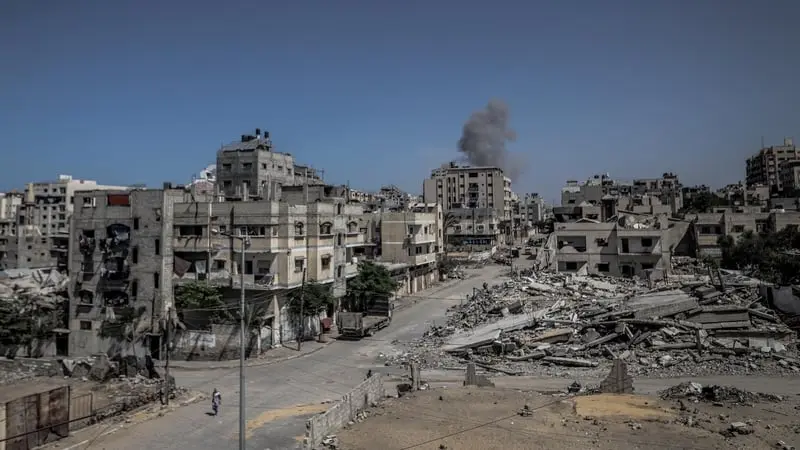
Trump’s 20-point Gaza peace plan promises ceasefire, hostage release, and reconstruction. Global leaders urge Hamas to accept and end the devastating conflict
What’s Inside Trump’s Gaza Peace Proposal? 20 Key Points That Could End the War
Published on:
Author: Rapido Updates
A Bold Plan for Peace: What Is the US Proposal?
Gaza Peace Proposal – On 29 September 2025, U.S. President Donald Trump unveiled a 20-point peace proposal aimed at ending the devastating war in Gaza. The plan was announced during a joint press conference with Israeli Prime Minister Benjamin Netanyahu at the White House. It promises an immediate ceasefire, the release of hostages, and a complete reconstruction of Gaza under international supervision.
The proposal has received support from several Arab and Muslim countries including Qatar, Egypt, Saudi Arabia, and Turkey. However, Hamas has not yet accepted the plan and is reviewing it with other Palestinian factions. The next few days are critical as the group decides whether to embrace peace or continue the conflict.
The 20 Key Points Explained in Simple Terms
Here are the main ideas from Trump’s peace proposal:
- Gaza will become a terror-free zone with no threat to neighbours.
- Rebuilding Gaza will be a top priority with global investment.
- Immediate ceasefire if both sides agree.
- Israeli forces will stop operations and prepare for withdrawal.
- All hostages (alive or deceased) will be returned within 72 hours.
- Israel will release 250 life-term prisoners and 1,700 Gazans detained since October 2023.
- For each deceased Israeli hostage returned, Israel will release remains of 15 Palestinians.
- Hamas members who surrender weapons and pledge peace will receive amnesty.
- Fighters who want to leave Gaza will be given safe passage abroad.
- Humanitarian aid will flow immediately — water, electricity, hospitals, bakeries, rubble removal.
- Relief will be managed by the UN, Red Crescent, and neutral agencies.
- Rafah crossing will be regulated under established mechanisms.
- A temporary Palestinian committee will govern Gaza, focusing on basic services.
- A “Board of Peace” chaired by Trump will oversee reconstruction and governance.
- Former UK Prime Minister Tony Blair will be part of the oversight team.
- Economic experts will design a redevelopment blueprint for Gaza.
- Gaza’s future will be shaped by international cooperation and investment.
- Israel will not annex or occupy Gaza.
- Palestinian Authority reforms will be supported and monitored.
- Global leaders will help ensure long-term peace and stability.
These points aim to create a “New Gaza” — peaceful, rebuilt, and free from violence.
Sources:Reactions from Around the World
Israel has accepted the plan, calling it a major step toward ending the war. Prime Minister Netanyahu said it “achieves our war aims.” Arab nations like Qatar, Egypt, and Saudi Arabia welcomed the proposal and urged Hamas to consider it seriously.
Hamas, however, has expressed concerns. The group wants changes in clauses related to disarmament and Israeli withdrawal. It also seeks guarantees against assassination attempts and clearer terms for Palestinian sovereignty. Talks are ongoing in Doha and Cairo, with mediators trying to bridge the gaps.
The European Union and United Nations have praised the humanitarian focus of the plan. Russia and China have called for a peaceful resolution, while some activist groups have criticized the proposal for favoring Israel.
Challenges and Criticisms
While the plan offers hope, it also faces criticism. Some experts say it lacks a clear path to Palestinian statehood. Others argue that placing Gaza under international control could weaken local leadership. There are also concerns about whether Hamas will truly disarm and whether Israel will follow through on troop withdrawals.
Critics have called the plan “colonial” and “imbalanced.” Some Muslim countries feel they were misled by last-minute changes made by Netanyahu. Activists have accused Arab leaders of compromising Palestinian sovereignty for geopolitical gains.
Despite these concerns, many believe the plan is a starting point for peace. The alternative – continued war – is far worse.
What’s Next: Countdown to Decision
Trump has given Hamas “three to four days” to respond. If the group accepts the plan, a ceasefire could begin immediately. Hostages would be released, aid would flow, and reconstruction would start. If Hamas rejects the proposal, Israel has warned of intensified military action.
Mediators from Qatar, Egypt, and Turkey are working around the clock. The world is watching closely. This could be a turning point in the long and painful history of the Gaza conflict.
Rapido Updates will continue to follow this story and provide accurate, timely coverage. Stay tuned for updates on this critical moment in Middle East diplomacy.